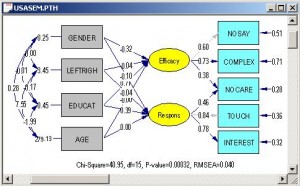SEM (Structural Equation Modeling), or better known as SEM is a multivariate statistical analysis method. SEM has differences in data processing regression or path analysis. SEM data processing is more complicated because SEM built by both measurement model and structural model.
To process SEM data easily, we need a statistical software. There are many software for SEM data such as: Lisrel , AMOS and Smart PLS . Among the statistical software, which is suitable for use. below’s a short review :
Advantages of Lisrel for SEM Structural Equation Modeling
Lisrel developed by Karl Joreskog and Dag Sörbom. Lisrel statistical software is the most familiar among researchers and practitioners. The advantages of the LISREL software is its ability to identify relationships between variables are complex. How to operate it consists of a choice, either with syntax and simple lisrel, making it more widely used in various discipline. Syntax certainly be favored for users who are familiar with the programming language. While SIMPLIS or simple LISREL is an alternative for those who are unfamiliar with programming languages.
A selection of various methods of estimation are available in lisrel, so do not cling to the Maximum Likelihood estimation method. It depends on the condition of the data, estimation methods which will be used.
Disadvantages of Lisrel
One of the disadvantages is its inability to process data with small sample size. When we have a sample of less than 200 samples, while the model is complex, it is sometimes the estimation results are not in line with our expectations.
Advantages of Amos for SEM Structural Equation Modeling
As with SPSS, AMOS is a statistical software developed by IBM. Amos software helps to examine the hypothesized relationship between variables. Through this software, we can determine the level of the strength of the relationship between both variables between the latent variables and the manifest variables. How significant relationship between the variables, and how fit model hypotheses compared with real data field.
With Amos, we do not need syntax or complicated programming language to operate the software. For beginners, or those who are unfamiliar with the programming language is an advantage. Through Amos, we simply describe the latent variables and manifest variables, and then connect it using arrows are available.
Disadvantage of Amos
Advantages of Amos as well as its disadvantages. We need to create many images when the model is complex, and it was very tedious work. Whereas in Lisrel, it is more simple with programming language. We just copy and duplicate the syntax, then running, then complete the model, as complex as any models we want.
Advantages of Smart PLS
Smart PLS or Partial Least Square is a statistical software with the same goal with lisrel and AMOS. They examines the relationship between variables, good fellow latent variables and indicator variables, or manifest.
Researcher uses Smart PLS when the subject has limited number of sample. While the model is built complex. It is not run when we use Lisrel or Amos. they require the adequacy of the sample.
Another advantage of Smart PLS is its ability to process data both the formative and reflective SEM model. Formative SEM models is a model when the indicator variables form a construct variable. So, the arrow head to construct variable from indicator variables. Otherwise, Reflective SEM Model is a model when a construct variable reflects its indicator variables. So that the arrow heads from the construct variable to its manifest variables. Statistically, the consequence is that there will be no error in the value of the indicator variable.
Disadvantages of Smart PLS
Therefore this software only to process data in small size, it is not suitable for research with large sample.
